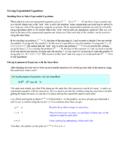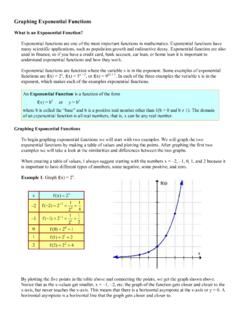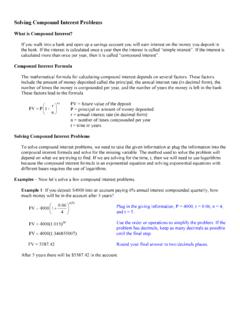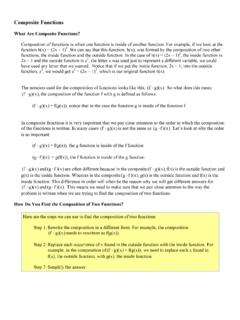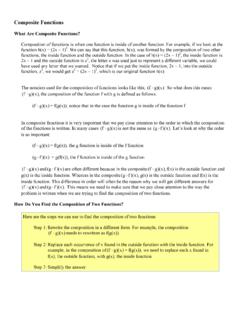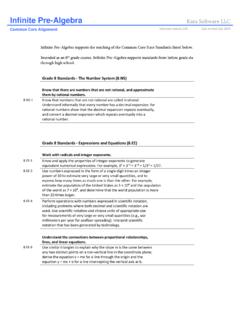Transcription of Solving Logarithmic Equations - Mesa Community …
1 Solving Logarithmic Equations Deciding How to Solve Logarithmic Equation When asked to solve a Logarithmic equation such as or the first thing we need to decide is how to solve the problem. Some Logarithmic problems are solved by simply dropping the logarithms while others are solved by rewriting the Logarithmic problem in exponential form. How do we decide what is the correct way to solve a Logarithmic problem?The key is to look at the problem and decide if the problem contains only logarithms or if the problemhas terms without logarithms. If we consider the problem this problem contains a term, 5, that does not have a logarithm. So,the correct way to solve these types of Logarithmic problems is to rewrite the Logarithmic problem in exponential form. If we consider the example this problem contains only logarithms. So,the correct way to solve these types of Logarithmic problems is to simply drop the logarithms. Properties ofLogarithms Revisited When Solving Logarithmic equation, we may need to use the properties of logarithms to simplify the problem first.
2 The properties of logarithms are listed below as a reminder. Solving Logarithmic Equations Containing Only Logarithms After observing that the Logarithmic equation contains only logarithms, what is the next step? This statement says that ifan equation contains onlytwo logarithms, on opposite sides of the equal sign, withthe same base then the problem can be solved bysimplydropping the logarithms. Properties for Condensing Logarithms Property 1: a 0 log 1 = Zero Exponent Rule Property 2: a 1 log a = Property 3: aaa log x log y log (xy) += Product Rule Property 4: aaa x log x log y log y -= Quotient Rule Property 5: y aa ylog x log x = Power Rule One To One Property of Logarithms If bb log M log N, = then M = N. 2 log (5x 7) 5 += 33 log (7x 3) log (5x 9), +=+ 2 log (5x 7) 5, += 33 log (7x 3) log (5x 9), +=+Let s finish Solving the problem 33 log (7x 3) log (5x 9). +=+ Since the problem has only two logarithms on opposite sides of the equal sign, the problem can be solved by dropping the logarithms.
3 Drop the logarithms. Finish Solving by subtracting 5x from each side, subtracting 3 from each side, and finally dividing each side by 2. Check the answer this is an acceptable answer because we get a positive number when it is plugged back in. Therefore, the solution to the problem 33 log (7x 3) log (5x 9) +=+ is x = 3. Here is another example, solve 777 log (x 2) log (x 3) log 14. -++= This problemcan be simplified by using Property 3 which changes the additionoflogarithms to multiplication. Drop the logarithms. Simplify the problem by distributing or FOILing and combining like terms. Solve the problem by subtracting 14 from each to get it equal to zero, and then factoring orusing the quadratic formula to find the values of x. Check the answers, only one answer is acceptable because the other answer produces a negative number when it is plugged back in. Therefore, the solution to the problem 777 log (x 2) log (x 3) log 14 -++= is x = 5.
4 Now that we have looked at a couple of examples of Solving Logarithmic Equations containing only logarithms, let s list the steps for Solving Logarithmic Equations containing only logarithms. 33 log (7x 3) log (5x 9). +=+ 7x 3 5x 9 +=+ x 3 = x 3 = 77 log ((x 2)(x 3)) log 14 -+= (x 2)(x 3) 14 -+= 2 x x 6 14 --= 2 x x 20 0 (x 4)(x 5) 0 x 4 or x 5 --= +-= = -= x 5 = Solving Logarithmic Equations Containing Terms without Logarithms After observing that the Logarithmic equation contains terms without logarithms, what is the next step? The next step is to simplify the problem using the properties of logarithms and then to rewrite the Logarithmic problem in exponential form. After rewriting the problem in exponential form we will be able to solve the resulting problem. Let s finish Solving the problem 2 log (5x 7) 5 += from earlier. This problem does not need to be simplified because there is only one logarithm in the problem.
5 Rewrite the problem in exponential form by moving the base of the logarithm to the other side. Simplify the problemby raising 2 to the fifth power. Solve for x by subtracting 7 from each side and then dividing each side by5. Check the answer this is an acceptable answer because we get a positive number when it is plugged back in. Therefore, the solution to the problem 2 log (5x 7) 5 += is x = 5. Steps for Solving Logarithmic Equations Containing Only Logarithms Step 1: Determine if the problem contains only logarithms. If so, go to Step 2. If not, stop and use the Steps for Solving Logarithmic Equations Containing Terms without Logarithms. Step 2: Use the properties of logarithms to simplify the problem if needed. If the problem has more than one logarithm on either side of the equal sign then the problem can be simplified. Step 3: Rewrite the problem without the logarithms. Step 4: Simplify the problem. Step 5: Solve for x. Step 6: Check your answer(s).
6 Remember we cannot take the logarithm of a negative number, so we need to make sure that when we plug our answer(s) back into the original equation we get a positive number. Otherwise, we must drop that answer(s). 2 log (5x 7) 5 += 5 5x 7 2 += 5x 7 32 += x 5 = x 5 =Here is another example, solveln(4x 1) 3. -= ln(4x 1) 3 -= This problem does not need to be simplified because there is only one logarithm in the problem. 3 4x 1 e -= Rewrite the problem in exponential form by moving the base of the logarithmto the other side. For natural logarithms the base is e. 4x 1 - Simplify the problembycubing e. Round the answer as appropriate, these answers will use 6 decimal places. x Solve for x byadding 1 to each side and then dividing each side by4. x Check the answer this is an acceptable answer because we get a positive number when it is plugged back in. Therefore, the solution to the problemln(4x 1) 3 -= is x Now that we have looked at a couple of examples of Solving Logarithmic Equations containing terms without logarithms, let s list the steps for Solving Logarithmic Equations containing terms without logarithms.
7 Steps for Solving Logarithmic Equations Containing Terms without Logarithms Step 1: Determine if the problem contains only logarithms. If so, stopand use Steps for Solving Logarithmic Equations Containing Only Logarithms. If not, go to Step 2. Step 2: Use the properties of logarithms to simplify the problem ifneeded. If the problem has more than one logarithm on either side of the equal sign then the problem can be simplified. Step 3: Rewrite the problem in exponential form. Step 4: Simplify the problem. Step 5: Solve for x. Step 6: Check your answer(s). Remember we cannot take the logarithm of a negative number, so we need to make sure that when we plug our answer(s) back into the original equation we get a positive number. Otherwise, we must drop that answer(s).Examples Now let s use the steps shown above to work through some examples. These examples will be a mixture of Logarithmic Equations containing only logarithms and Logarithmic Equations containing terms without logarithms.
8 Example 1: Solve 3 log (9x 2) 4 += This problem contains terms without logarithms. This problem does not need to be simplified because there is only one logarithm in the problem. Rewrite the problem in exponential form by moving the base of the logarithm to the other side. Simplify the problembyraising 3 to the fourth power. Solve for x by subtracting 2 from each side and then dividing each side by 9. Check the answer this is an acceptable answer because we get a positive number when it is plugged back in. Therefore, the solution to the problem 3 log (9x 2) 4 += is 79 x. 9 = Example 2: Solve 44 log x log (x 12)3 +-= This problem contains terms without logarithms. This problemcan be simplified by using Property 3 which changes the additionoflogarithms to multiplication. Rewrite the problem in exponential form by moving the base of the logarithm to the other side. Simplify the problemby distributing and cubing the 4. Solve the problem bysubtracting 64 from each to get it equal to zero,and then factoring orusing the quadratic formula to find the values of x.
9 X 16 = Check the answers, only one answer is acceptable because the other answer produces a negative number when it is plugged back in. Therefore, the solution to the problem 44 log x log (x 12)3 +-= is x = 16. 3 log (9x 2) 4 += 4 9x 2 3 += 9x 2 81 += 79 x 9 = 79 x 9 = 4 log (x(x 12)) 3 -= 3 x(x 12) 4 -= 2 x 12x 64 -= 2 x 12x 64 0 (x 4)(x 16) 0 x 4 or x 16 --= +-= = -= 44 log x log (x 12)3 +-= 3 log (9x 2) 4 +=Example 3: Solve 444 log (2x 1) log (x 2) log 3 +=+- This problem contains only logarithms. This problemcan be simplified by using Property 4 which changes the subtractionoflogarithms to division. Drop the logarithms. Simplify the problem by cross multiplying to get rid of the fractions. Solve the problem bydistributing the 3, subtracting x from each side, subtracting 3 fromeach side, and finally dividing by 5. No Solution Check the answers, this problem has No Solution because the only answer produces a negative number and we can t take the logarithm of a negative number.
10 Therefore, the problem 444 log (2x 1) log (x 2) log 3 +=+- has no solution. Example 4: Solve log(5x 11) 2 -= This problem contains terms without logarithms. This problem does not need to be simplified because there is only one logarithm in the problem. Rewrite the problem in exponential form by moving the base of the logarithm to the other side. For common logarithms the base is 10. 5x 2 100 -= Simplify the problemby squaring the 10. Solve for x byadding 2 to each side and then dividing each side by5. Check the answer this is an acceptable answer because we get a positive number when it is plugged back in. Therefore, the solution to the problemlog(5x 11) 2 -= is 102 x. 5 = log(5x 11) 2 -= 2 5x 2 10 -= 102 x 5 = 102 x 5 = log(5x 11) 2 -= 444 log (2x 1) log (x 2) log 3 +=+- 44 x 2 log (2x 1) log 3 + += x 2 2x 1 3 + += 3(2x 1) x 2 +=+ 6x 3 x 2 1 x 5 +=+ = -Example 5: Solve 22 log (x 1) log (x 4) 3 +--= This problem contains terms without logarithms.
